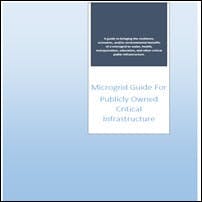This guest post is adapted from a new white paper from the DOE’s Rima Kasia Oueid that outlines the three microgrid development phases for public critical infrastructure microgrids. This entry explores Phase 3: Implementation.
Download the full report.
Implementing a microgrid requires significant time, effort and investment. There are many cost variables that must be considered when evaluating a microgrid investment which requires significant upfront capital. These variables include capital costs, operating and maintenance costs, utility (electric and gas) rates, interconnection costs, environmental standards, energy load requirements corrected for local weather conditions, and regulatory requirements.
In the last of three microgrid development phases, the project team is entering the project execution phase to develop deliverables or tasks that will be tied to the actual microgrid construction project.
Feasibility studies
The primary purpose of the feasibility study is to determine requirements and estimate the size of the system (e.g. site requirements, load requirements, DER requirements, objectives, drivers, etc.) and provide a cost/benefit analysis that considers multiple options within a specified degree of accuracy. In contrast, the preliminary feasibility studies conducted earlier provide basic information on whether a microgrid is needed or even feasible based on the site and customer load. The feasibility study should consider and assess several microgrid design options that reveal the trade-offs between economic, environmental, and engineering optimality.
Conceptual design phase
The purpose of this analysis is to conduct deeper analysis to confirm if microgrids are a viable option, both financially and technically at your facility. This will include analysis on controls/communication, and system and regulatory requirements.
The conceptual design will provide more detail on the microgrid components, as well as tactical and installation applications. Conceptual designs are typically performed by design and build engineering firms. This work includes site descriptions, microgrid project objectives, design basis and rationale, as well as performance criteria. For example, this will include critical loads, services and power outage considerations, and step-by-step instructions on the microgrid evaluation and analysis. The performance-based design should also leverage energy surety metrics. This phase will include exercises in evaluating, analyzing, and developing microgrid options, and estimating associated benefits and costs.
NEPA, environmental reviews, permitting
Before construction can begin, the project team will need to ensure that all NEPA (National Environmental Policy Act), as well as state and local environmental reviews, assessments, and permits are complete where required. This includes obtaining any relevant categorical exclusions. Assuming NEPA, or some kind of EIS (environmental impact statement) applies, then project construction cannot begin until proper reviews are complete for each project. This can be done by a state or local environmental office for publicly owned facilities pursuing microgrids with some support from private contractors as needed. Privately owned microgrids may need to obtain their own staff to facilitate the environmental review process in coordination with the relevant state or local environmental review office. In almost all cases, permitting will be required, particularly if there is an interconnection to the grid or substation.
The conceptual design will provide more detail on the microgrid components, as well as tactical and installation applications.
Construction and risk
This is the final phase in the development of the microgrid project. Although operations and maintenance will be required post-construction, construction is the final step in getting the microgrid(s) online. This is also the phase of the project that involves the greatest amount of risk to execution.
The project team should ensure that the technologies used in the microgrid have adequate warranties from vendors that can honor them to minimize technology risk. (Photo: Shutterstock/By Sonpichit Salangsing)
However, there are strategies to help the project team minimize risk through proper planning (e.g. contingency plan), risk mitigation, or the transfer of risk to other parties willing to assume those risks at reasonable cost. Although not exhaustive, the primary risks associated with construction include:
Technology risk. Occurs when the microgrid does not meet performance specifications despite proper design, manufacturing, and installation. Root causes can be addressed as follows:
- Complete feasibility studies, site analysis, detailed and conceptual design, as well as engineering design to select the most appropriate technologies to the project location (s) and needs
- Rely on proven or commercially available technologies
- Hire proper workforce or obtain training in the proper use and maintenance of the technology
- Identify alternative technologies
The project team should ensure that the technologies used in the microgrid have adequate warranties from vendors that can honor them to minimize technology risk.
Legal/regulatory risk. Legal risk stems primarily from misinterpretation of laws and regulations, as well as changes in laws and regulations, or the application of laws and regulations, that would negatively impact the project. Many legal risks could be mitigated through the collaboration with stakeholders throughout the process. The project team will need to ensure they have access to competent legal, regulatory, and contracting experts to include contract provisions, such as indemnity and warranties, to minimize legal/regulatory risk.
Performance risk. Competent vendors and appropriate project specifications can help minimize performance risks, but they cannot eliminate all performance risk. To increase the probability of success, the project team may want to ensure transparency in the vendor selection process. Proper warranties, construction bonding requirements, and provisions for liquidated damages can be negotiated with contractors or vendors. Other performance risks have operational barriers or interdependencies, such as interconnection and dispatch requirements. Often, these performance risks can be addressed through proper relationship management and facilitated meetings. Otherwise, issues may need to be escalated through appropriate channels and adequate time will need to be budgeted to accommodate anticipated performance risks. It is rare for there to be no delays in equipment delivery, the aligning of interdependent projects, obtaining vendors or contractors, building an adequate workforce, etc. Therefore, it is prudent to budget additional time and funding to help buffer performance risks.
Payment risk. Payment risk is addressed through a combination of appropriate capital structures, and due diligence. Appropriate capital structures can help ensure that equity and debt holders are being compensated fairly and there is transparency to show what each party is due. Due diligence involves appropriate review of customers and suppliers for creditworthiness, credit enhancements, revenue projections, debt obligations, firm obligations to pay for performance, credit insurance and more.
Operations and maintenance
Proper operations and maintenance are key to maximizing the value of a microgrid over the long run. Depending on the project structure, operations and maintenance could be done internally by the owner, developer, or it can be outsourced to a third party. If done by a third party, the operations and maintenance may be included as part of a PPA (purchase power agreement) or a separate service agreement. In some cases, the third party could also be the local utility. The project team will need to evaluate all options and pursue the one that best meets their needs and goals.
This series also covered the following topics over the past few weeks:
- Exploring the 1st Development Phase of Public Infrastructure Microgrids
- Dissecting the Planning Phase of Public Infrastructure Microgrid Development
This guest post was written by the DOE’s Rima Kasia Oueid. She is a senior policy adviser at the U.S. Department of Energy. This article is an excerpt adapted from her comprehensive report, “Microgrid Guide for Publicly Owned Critical Infrastructure,” available for free download.








